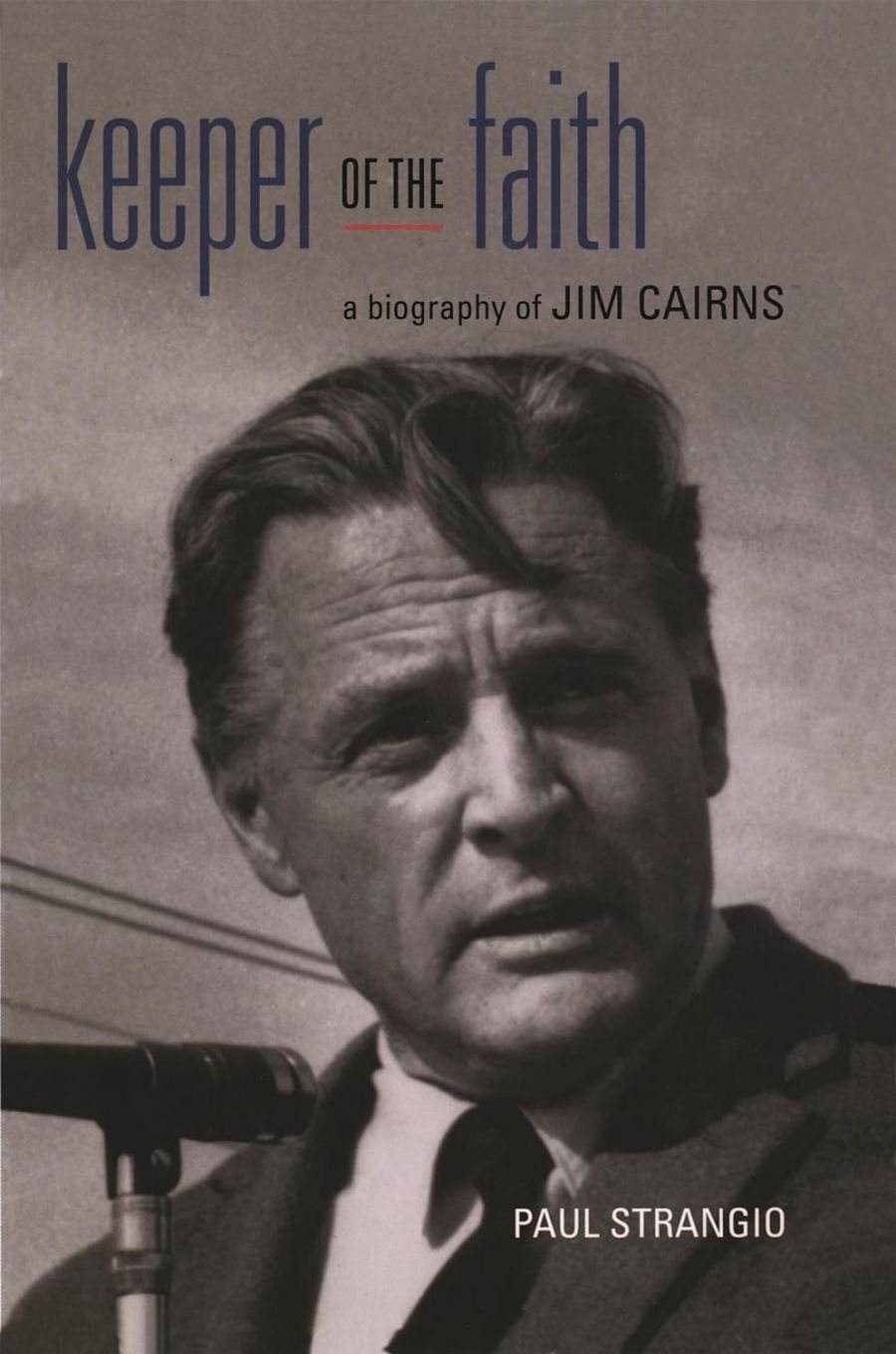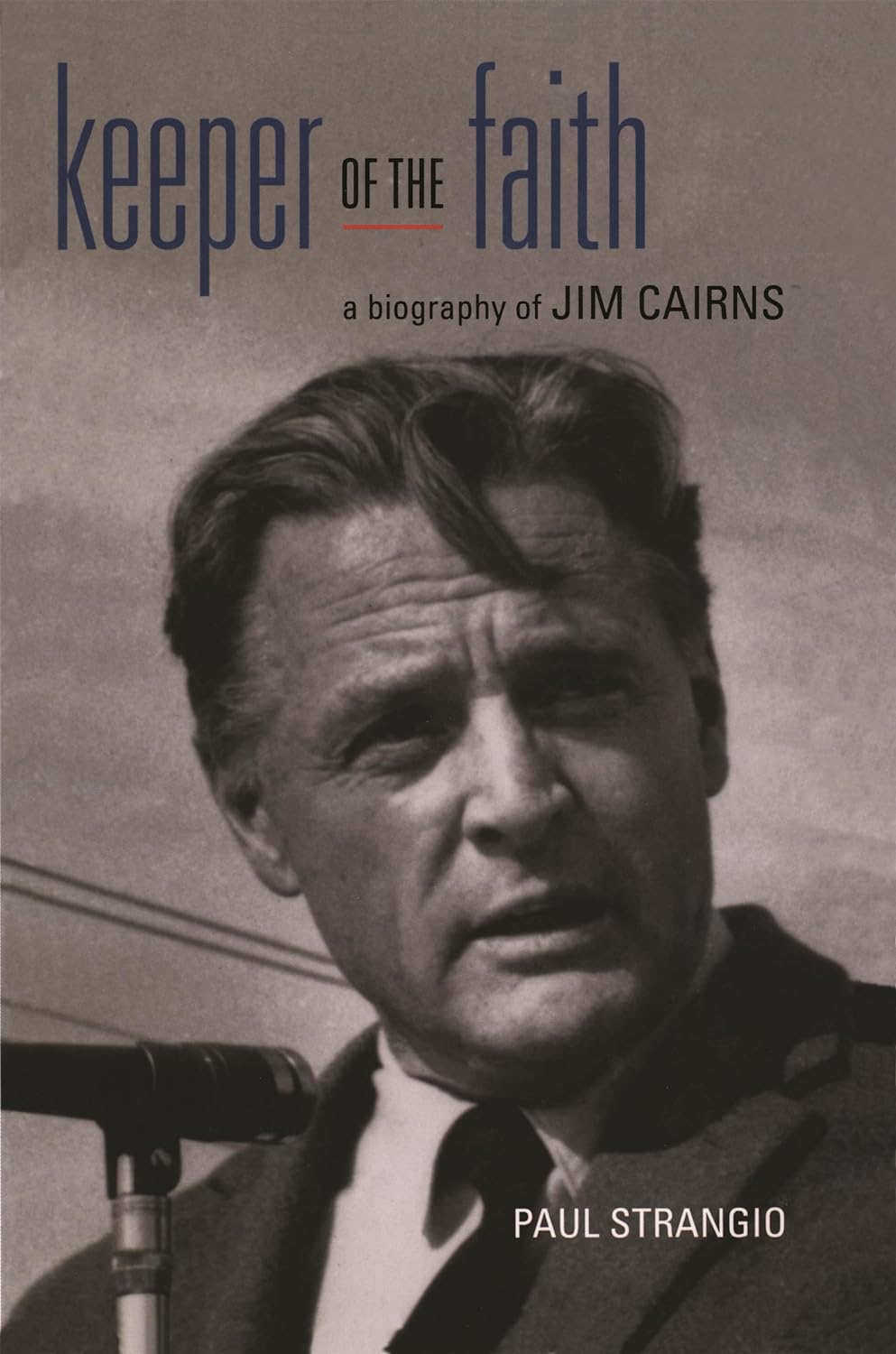
- Free Article: No
- Contents Category: Biography
- Review Article: Yes
- Article Title: Labor’s Grand Emotional Refugee
- Online Only: No
- Custom Highlight Text:
First, a disclaimer. Since 1975 I’ve had a sneaking affection for Jim Cairns. At that time, I was flirting with various environmental causes – as you do at the age of nine. I circulated some petitions at my primary school calling for the preservation of the Tasmanian south-west from its concrete-crazed Hydroelectricity Commission. I forwarded these to a string of political power-brokers, identified rather shrewdly by their appearances on the ABC news.
- Book 1 Title: Keeper of the Faith
- Book 1 Subtitle: A biography of Jim Cairns
- Book 1 Biblio: MUP, $49.95 hb, 464 pp, 0 522 85002 2
- Book 1 Cover Small (400 x 600):

- Book 1 Cover (800 x 1200):

The Queen, unfortunately, was a bit busy. So, too, that funny-sounding Mr Whitlam, who didn’t even sign his reply. But Mr Cairns – why, he couldn’t have been nicer. He admitted he didn’t know much about the Gordon and Franklin Rivers, but promised to look into the many interesting facts I had brought to his attention, all of them carefully cribbed from Four Corners. What I remember most, though, was the physical letter. It was on a slightly wacky yellow notepaper with some exotic hippy letterhead, and was so strewn with errors and crossings-out that the postscript read: ‘With apologies for my typing.’
Although my mum commented with asperity that Junie Morosi must have had the day off, that letter from Jim Cairns rather endeared him to me then. It still does. And it was obvious at the launch of Paul Strangio’s new biography of Jim Cairns, held at Melbourne Trades Hall, that the personal touch and radical accent that he lent politics throughout the 1960s and 1970s had touched many other lives. The atmosphere, as it often is at such occasions, was unabashedly nostalgic and uniformly disillusioned. Thank God for the Labor Party. Wasn’t it wonderful? It was easy to share the general feeling of exultant dejection. Politics has been transfigured beyond recognition. In the good old days, WWF stood recognisably for Waterside Workers’ Federation; now it’s the World Wildlife Fund at best, and more likely the World Wrestling Federation. Nowadays, too, you tend to think that Cincinnatus could get on with his ploughing; politics being a career rather than a calling, the gifted outsider is unwelcome. All of which makes Strangio’s task as a biographer more, rather than less, difficult: how to reconcile his obvious sympathy for the values of the old Left with the need to assess Cairns’s career, which was an heroic failure.
Actually, on one level, Strangio makes a pretty good fist of this. He is not afraid to judge his subject. I cringed inwardly at the author’s promise in the Introduction to deploy tools of ‘psycho-biography’ in Keeper of the Faith, but was pleasantly surprised at how deft and undogmatic were their application. Strangio is fortunate to have had access to the notes of Cairns’s previous biographer, Paul Ormonde, and transcripts of interviews to which Cairns agreed thirty-four years ago with a Monash psychologist, John Diamond; Cairns was disarmingly candid with both, especially Diamond. It emerged that the man who, on the podium and in parliament, could appear remote was, in real life – surprise, surprise – remote. ‘The whole thing is a story of not much involvement with people,’ Cairns said of his life. ‘There was certainly no time when I was different.’ Given that Cairns spent his political career consumed by concern for ‘the people’ and ‘society’, there is something desperately poignant about how abstract these concepts remained in his quotidian affairs. Strangio describes Cairns expertly, though not unsympathetically, as ‘a permanent emotional refugee’, his ‘grand schemes for humanity’ a means of avoiding ‘personal contemplation’, reinforced by ‘a subtle narcissism, most conspicuously reflected in a vanity that he could change the world’. If this sounds astringent, it’s no more so than some of Cairns’s own occasional self-reflections, such as the comment in Oil in Troubled Waters (1976) that he had developed ‘an inward-looking kind of self-denial which made people think I was unselfish and this became for me a favourable political image’.
Unfortunately, the few concluding pages where Strangio meditates on Cairns’s emotional make-up are a long time coming. Elsewhere, Keeper of the Faith makes rather turgid reading. Partly this is because Cairns, while he did colourful things, was not himself a colourful man. His personal austerity allowed for little humour and limited imagination. Strangio quotes some 1952 correspondence involving G.D.H. Cole, who supervised Cairns’s doctorate, and John La Nauze, Cairns’s boss in Melbourne University’s economic history department, concerning Cairns’s suitability for academic promotion. Cole thought Cairns ‘not … an academic type, nor is he a very clever man’, though ‘sensible and well-informed’; La Nauze agreed that Cairns was ‘not an outstanding scholar of the research kind’, but ‘a hard worker’. Strangio finds these remarks ‘patronising’, but they seem fairly acute.
Partly, however, Strangio’s book is burdened by not being a book. It is a Ph.D. It has been edited to a degree but, frankly, should have been completely rewritten. And I’d like to share here a personal parti pris, not specific to Keeper of the Faith: the practice of academic presses publishing Ph.Ds is demented. It accelerates their marginalisation, panders to academic vanity and credentialism, and leads us further down the twin paths of greater specialisation and increased uniformity. Why are university publishing houses churning out books with audiences of approximately three at best, including the author’s mum? There. I’ve said it.
To repeat, this remark is not specific to Keeper of the Faith; it’s not the dreariest Ph.D. redux I’ve read, perhaps because I have always found its subject interesting. But it is, frankly, often as not, a lifeless and repetitive reading experience. The phrase ‘agent of social change’, or some minor variation on it, must be repeated a thousand times. The obvious, especially where it concerns Cairns’s ambivalence about organised democracy, is often laboured to death. The book conveys little sense of what Cairns is like to be with or to observe, of his personal tastes, of his opinions beyond politics, or even if he has any. The book scarcely contains any anecdotes, the stuff of life in biography. Instead, there are endless slabs of quotes from press reports. One of the very few descriptive comments concerns Cairns’s ‘trademark parliamentary style’, which was ‘an impassive monotone, his face expressionless’: it could describe Strangio’s utterly wooden prose.
This, though, is more than a question of writing; it is a matter of vision. Writing about people entails more than accommodating them on some psychological continuum; it is about skill in conveying character, and a fascination with the factors that foster it and the chance happenings that inflect it. Strangio, for example, mentions a Sunbury schoolmaster, John Rogers, whom fourteen-year-old Cairns esteemed, and who gave him a copy of William Morris’s News from Nowhere, or An Epoch of Rest (1890). It was Cairns’s first real exposure to political thought, and should be a powerful moment in the story. An alert narrator might be struck that Cairns’s introduction to socialism came not through a union pamphlet or a tract on political economy, but through a utopian novel, given Cairns’s subsequent infatuation with various New Jerusalems. This narrator might also note that Morris wrote News from Nowhere even as his six-year-old Socialist League fell apart, given that Cairns was to find the path to utopia similarly torrid. Perhaps we could learn more about the utopian tradition of which News from Nowhere was a part, for Morris’s perfected pastoral England was a response to Edward Bellamy’s Looking Back 2000–1887 (1888), which had projected a future world that was stark, impersonal and bureaucratic. Perhaps we could learn something of Australia’s particular place in utopian thinking: here I am recalling Marilyn Butler’s provocative Deakin Lecture, ‘Facing Two Oceans’, last year. Something. Anything. But Rogers, Morris and News from Nowhere go straight back to nowhere in a paragraph.
Chances are that you’re either nodding agreement at the moment, or composing an outraged letter to the editor, so further comment is superfluous. Essentially, Paul Strangio has completed a quite satisfactory thesis. But it’s a thesis. And a thesis is a research assignment completed in pursuance of a qualification, involving perusal by one or more examiners. It is, in other words, an academic talking to other academics, usually in the clunking, creaking, monotonous vernacular of modern Humanities departments. Keeper of the Faith stands a better chance than most réchauffé Ph.Ds of reaching an audience beyond the groves of academe. Cairns still enjoys great goodwill in his generation and, if the atmosphere at Trades Hall was anything to go by, tales of political disillusionment strike a particular chord with erstwhile true believers these days. But the reason I remember Jim Cairns’s letter all these years later is because it was personal, arresting, distinctive, unusual: all the things that his biography isn’t.


Comments powered by CComment